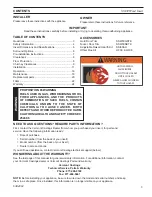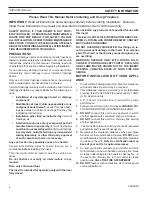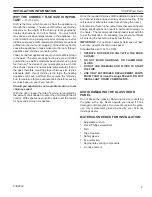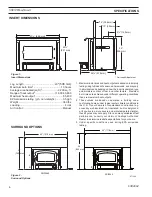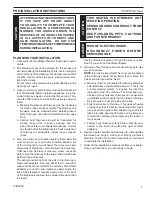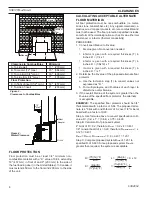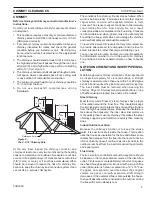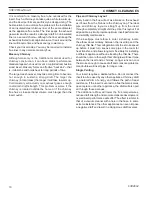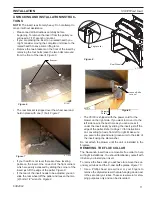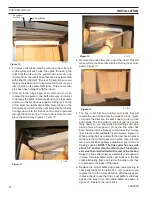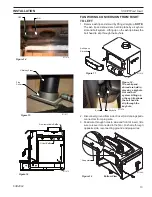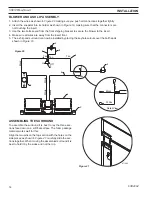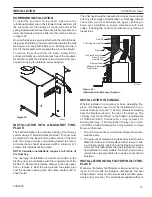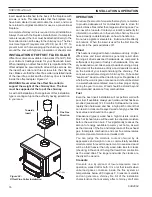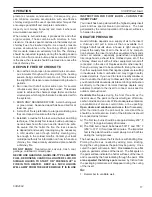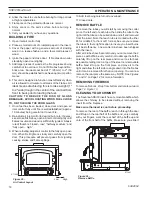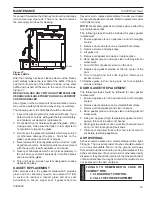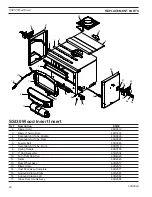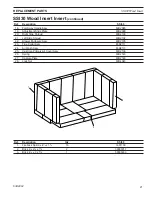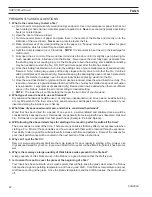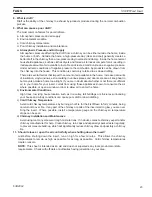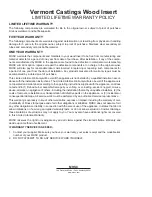
SSI30 Wood Insert
63D4004
17
OpERATION
promote creosote condensation. Consequently, you
can minimize creosote accumulation with an effective
chimney design and the use of operational techniques that
encourage good draft and complete combustion.
Inspect your chimney frequently and clean it whenever
accumulation exceeds 1/4".
When wood is burned slowly, it produces tar and other
organic vapors. These combine with moisture to form
creosote. Creosote vapors condense in the relatively cool
chimney flue of a slow burning fire. As a result, creosote
residue accumulates on the flue lining. When ignited,
this creosote makes an extremely hot fire. The chimney
should be inspected regularly during the heating season
to determine if a creosote build-up has accumulated. If this
is the case, the creosote should be removed to reduce the
risk of chimney fire.
kEEp uNIT FREE OF CREOSOTE
1. Burn with air control open for several minutes at numer-
ous intervals throughout the day during the heating
season, being careful not to over-fire unit. This removes
the slight film of creosote accumulated during low burn
periods.
2. Burn insert with draft control wide open for several
minutes every time you apply fresh wood. This allows
wood to achieve the charcoal stage faster and burns
wood vapors which might otherwise be deposited within
the systems.
3. BURN ONLY SEASONED WOOD. Avoid burning wet
or green wood. Seasoned wood has been dried for at
least one year.
4. A small hot fire is preferable to a large smoldering one
that can deposit creosote within the system.
5. Establish a routine for the fuel, wood burner and firing
technique. Check daily for creosote build-up until expe-
rience shows how often you need to clean to be safe.
Be aware that the hotter the fire, the less creosote
is deposited and weekly cleaning may be necessary
in mild weather even though monthly cleaning may
be enough in the coldest months. Contact your local
municipal authority for information on how to handle a
chimney fire. Have a clearly understood plan to handle
a chimney fire.
dO NOT buRN:
Treated wood, solvents, trash, coal,
garbage, cardboard, colored paper
NEvER uSE gASOlINE, gASOlINE-TYpE lANTERN
FuEl, kEROSENE, ChARCOAl lIghTER FluId, OR
SIMIlAR lIquIdS TO START OR “FREShEN up” A
FIRE IN ThIS hEATER. kEEp All SuCh lIquIdS
WEll AWAY FROM ThE hEATER WhIlE IT IS IN uSE
INSTRuCTION FOR FIRST buRN – CuRINg ThE
INSERT pAINT
Your insert has been painted with the highest quality insert
paint and has special break-in procedures. The heat
generated by the normal operation of the insert, will serve
to harden the paint.
NEgATIvE pRESSuRE
Good draft also depends on a supply of air to the insert;
a chimney can’t pull in more air than is available to it.
Sluggish draft results when a house is tight enough to
prevent the ready flow of air to the insert, or by competi-
tion between the insert and other equipment that sends
indoor air outside - especially power-driven equipment
like range hoods, exhaust fans, clothes dryers, etc. If the
chimney draws well with all other equipment turned off
(or sealed, in the case of fireplaces and/or other inserts),
then you simply need to be careful with timing the use of
the other equipment. Note that negative pressure resulting
in inadequate indoor combustion air may trigger nearby
smoke detectors. If you need to crack a nearby window or
door to enable the chimney to draw well, that’s a sign that
you should install an outside-air intake to bring combustion
air directly to the insert. Vermont Castings dealers carry
adapters to attach to the insert to connect an air duct for
outdoor combustion air.
ventilate the house
during the first three times the
insert is used. The paint on the insert will give off smoke,
carbon dioxide and an odor. Without adequate ventilation,
concentrations of smoke could irritate, or be upsetting.
Open doors and windows and use a fan
if necessary.
After the initial burns the paint will be cured and there
should be no more smoke. Each of the initial burns should
be conducted as follows:
A) The first two burns should be at approximately 250° F
(120° C) for approximately 20 minutes.
B) The third burn should be between 500° F and 700° F
(260° to 370° C) for at least 45 minutes. The important
fact is the paint should be cured slowly. Avoid hot fires
during the curing process.
The best way to achieve the first burn is with kindling fires.
Prolong the fires as needed by adding more kindling.
During the curing process the paint may be gummy. Once
cured the paint will remain hard.
It is normal
to see flat
spots on painted surfaces of the insert. The flat spots on
the paint surface indicate the hotter surfaces of the insert,
and is caused by the heat radiating through the paint.
It is
also expected that shiny spots
caused by friction from
the packaging materials, will disappear during the curing
of the insert.
So:
1. Remember to ventilate well.

